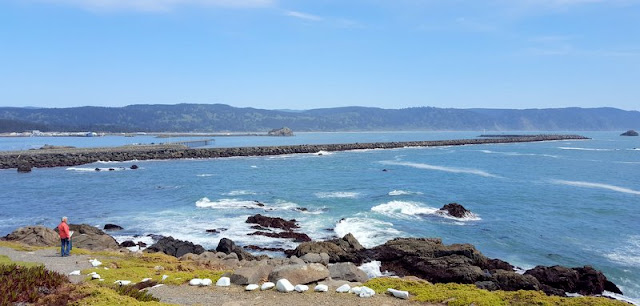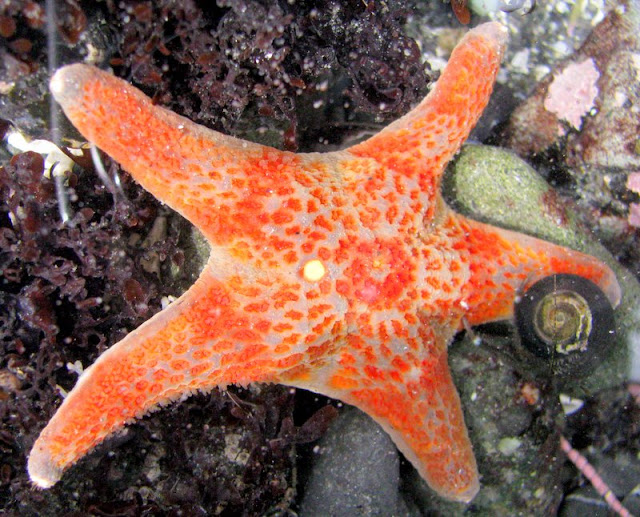Some of those curves have had a rough winter. There is much road work being done along Highway 101, making the drive a little challenging. This section of one-lane traffic features the side of the mountain to our right, and a cement barricade on the left. There is no where to detour traffic, since that is a drop-off down to the ocean on the other side of that construction truck.
We are headed to the tiny town of Smith River, California. If you google "Smith River" you will see that it is the cleanest river in the lower 48 states. This emerald green river is un-dammed for its entire stretch through the mountains, and we were told that it's the holy cradle for wildlife because of its pristine water quality.
We have two sight-seeing missions while we are staying here. One is to the nearby Jedediah Smith State Park. From our spot in Smith River, it's a dirt road drive from the ocean into the mountains.
For those that don't hike, driving this road is the next best thing to hiking through the ancient redwoods. There were many times when we could stick our arms out our car windows and both touch a redwood at the same time. This is the narrowest dirt road we have seen, so some of the magic is lost in wondering what your options will be if a car comes around that blind curve going the opposite direction.
The good news is that not many people will attempt this muddy road filled with pot holes, so we met only a few in our drive up the mountain. We both laughed (nervously) when we passed the "road narrows" sign and wondered how it could get any more narrow. We pulled into the small parking lot for the Stout Grove trail head with a few other hardy hikers, and headed down the trail. You should know the redwood hike drill by now--look for one of us standing at the base of the tree to give some scale to the majesty of these 300-foot-tall trees.
We are here because of several different recommendations from fellow travelers we have met along the way. The first was while looking at California poppies at Antelope Valley. A young guy that had just returned from photographing the fjords of Norway, told us that this was his favorite place in the entire world. He gave us directions down that muddy road, even though he claimed he didn't often share this location with others. So of course we had to come here!
We love these hikes among the old-growth redwoods that are the tallest living things in the world. No fences, no crowds--our favorite kind of trail. Again, these trees were saved from the logging of early settlers to the west coast because of that terrible road we just drove. There was no way to get that lumber down to the people wanting to build houses in the valley. So they were saved until conservationists could rescue them for us to enjoy today. Of the bounteous forests of redwoods that once stood proudly on this coast, 95% were cut down for their lumber. The remaining 5% are only left because a group of concerned citizens raised the money to purchase those forests away from the logging companies.
In between all those trees are lovely spots of green competing for the limited sunlight streaming through the redwood canopy. The ferns are now unfurling their new spring fronds.
We thought that the redwood trees would be like the Sequoias we saw in central California--confined to just one or two parks. But as you can tell from so many blog entries with Redwoods, they stretch from San Francisco all the way to southern Oregon. So there are many places to see giant redwoods. But Stout Grove is one of our favorite places of them all.
We have learned much about these redwoods as we have wandered through so many forests. For example, they can live for 2,000 years. But they grow to most of their soaring height in the first 100 years. Once they reach the forest canopy, they only grow a few inches per year in height. At that point, they use their energy to making their core bigger around. This ancient redwood forest is tucked along that beautiful blue Smith River that is running beside us now.
As we walked back out of the Stout Grove, we found that our hiking trail became a wide and paved sloping path. We laughed to think that this trail was wider and in much better shape than the road we had driven to get here.
We made the drive back out of the forest to return to the coast. We were just in time for low tide--the perfect time to visit Battery Point Light House. Built on an islet outside of Crescent City, the walk to the light house is under water during high tide. But for now we could walk across the rocky isthmus with dry feet.
This little lighthouse was built in 1856, and remained in service until 1965. After a short "vacation," it was reactivated as a private aid by the local historical society.
So it is still a working lighthouse, and the lighthouse keeper's residence is still in use today.
That keeper of the light has a beautiful view north up the coast . . .
as well as to the south to the jetties of Crescent City.
After some nice blue-sky days, we see that there is a ring around the sun. We don't know what that means on the coast, but in the midwest a ring around the moon means storms are coming. We couldn't stand to look at the ring with our bare eyes, so this picture was taken through Mark's polarized sun glasses.
We decided to take advantage of the low tides to see what the Crescent City beach tide pools were hiding. These rocks are usually covered in water, but right now we could walk out on them.
Tide pooling is like looking down into one of those expensive salt water aquariums. You never know what has been trapped in the clear water of these rock crevices as the tide receded.
As you can tell from the picture above, one of the fun things to find can be a sea star.
Because they are alive and moving, they often don't look like perfectly spaced five-pointed stars. They can be draped across the rock surfaces in odd shapes in the tide pools.
This was a really odd-shaped sea star. At one time he was quite comfortable while he was surrounded by ocean water, clinging to the rocky surface. Now, not so much.
We got a side-ways view of this guy, including the tiny suction cups on his underside that holds him in place.
We also found this good-sized anemone, with only a few tentacles sticking out in this shallow water pool.
There were hermit crabs and and snails clinging onto rocky surfaces, as well as this curious marine life. It took Mark some serious googling time to find that this is a haliclona permollis. The scientific name seems a little formal, so we prefer its more common name--purple encrusted sponge.
The pastels must be the preferred sea color, as we saw pink in other lacy rock coverings under the water today.
Buying a ticket to a nice aquarium along the coast is a good way to learn about the ocean. But we much prefer discovering the marine life in nature right at our feet.
As we made our way back to where our motor home is parked in the town of Smith River, we had to stop to see the big herd of elk that were congregating close to the ocean.
There's a grassy meadow near a beached ship that made an interesting back drop to this beautiful herd.
They were all standing at attention as we drove by. The sight that has peaked all of their interest--a couple helping their child on one of her maiden bicycle rides down the neighborhood street.
Smith River's city sign touts it as the "Easter Lily Capitol of the World." We drove down back roads looking for lilies. Perhaps they have just recently been harvested to be shipped around the country for Easter, because we didn't find any in the fields. We did find Tolowa Dunes State Park, where we took a walk along the beach. We saw three guys with fishing poles, and so we walked closer.
We were sure wishing to see one of them catch a fish, and it wasn't long before we got our wish.
When he saw our camera, he even turned around to show off his catch.
We have gotten pretty good at starting conversations with complete strangers. That is made easier when you ask people about something they really like to do--like fishing in the ocean. We got lots of interesting information from a guy that has been fishing here for most of his life.
For bait, he uses the sand crabs that are readily available right below the surface of the sand. They are about the size of a quarter, and are easily placed on the hook. The tides were just right for schools of red-tailed surf perch to be coming in close to shore to feed. He was getting a bite within ten seconds every time he threw out a new line.
It took a mighty yank to set the hook, and it's a good idea to be wearing something you don't mind getting wet. That's because it's too hard to watch a fishing pole and the waves at the same time.
As he walked another fish to his bucket on the beach, he offered us his pole so we could try it. Denisa has been kicking herself ever since for not taking him up on his offer.
There were times when we saw all three fishermen with fish on the line at the same time. That was a sizable school of hungry perch just waiting to be caught. He would easily catch his limit as his bucket got fuller while we were watching.
It's hard for us to get used to the diverse geography that Californians enjoy. As we walked back to our car at the beach, we could look straight east to see mountains with snow on them. That's a picture of just how close the ocean is to the high peaks in this state.
Our last stop of this fun-filled-day was the beach just a half-mile from where we are staying. Since we knew we would be sight-seeing most of the time, we are boondocking in the parking lot of the local casino in Smith River. We are very close to the estuary where the Smith River meets the ocean. In the picture below, we see the mouth of the river to the left, and the waves of the ocean on the right.
We noticed rows of seals on the sandy beach in front of us, and we were ready to leave and dismiss this as yet another nice beach sighting. That's when we struck up a conversation with a man standing on the shore. He was a self-proclaimed expert on this estuary, and he was the one that let us know that we were looking at the holy cradle of marine biodiversity and one of the cleanest rivers in the world.
On Sunday morning, the preacher even mentioned in his sermon that the Smith River was the cleanest river in the lower 48 United States, and we read more about that later. So to our untrained eyes we almost dismissed our opportunity to witness another of the "best of" places in this great country of ours.
When we left the motor home this morning, all we had on our itinerary was a walk through a redwood grove. The lighthouse, tide pools, fishing, elk, and the cleanest estuary were just things we stumbled upon as we wandered. It was a day full of wildlife sightings and beautiful landscapes. We have once again wandered into more of God's wonders, and we're loving this journey.











































No comments:
Post a Comment